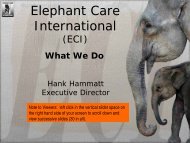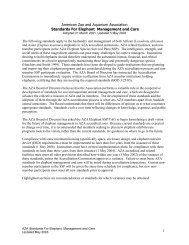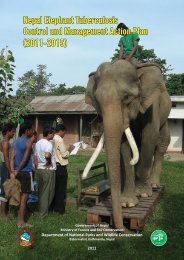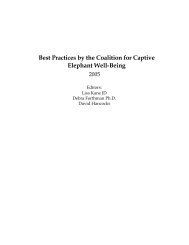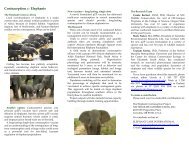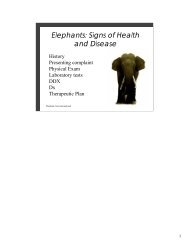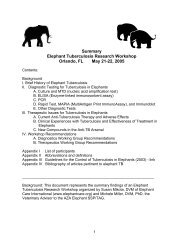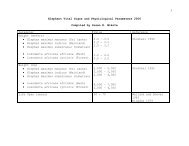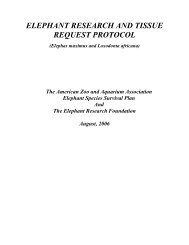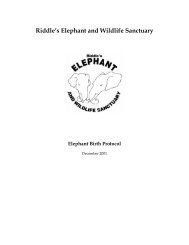Let Them Be Elephants!.pdf - Elephant Care International
Let Them Be Elephants!.pdf - Elephant Care International
Let Them Be Elephants!.pdf - Elephant Care International
You also want an ePaper? Increase the reach of your titles
YUMPU automatically turns print PDFs into web optimized ePapers that Google loves.
<strong>Let</strong> them be elephants!<br />
Hilda Tresz and Heather Wright<br />
Phoenix Zoo<br />
1
The Phoenix Zoo<br />
Currently houses three female Asian<br />
<strong><strong>Elephant</strong>s</strong><br />
The zoo, through various circumstances,<br />
acquired<br />
• Indu -1998<br />
• Reba – 1999<br />
• Sheena - 2000<br />
All three came from other organizations with a variety of health and<br />
behavioral problems, some of which have been exasperated since arriving at<br />
our facility . Each of these elephants has has a troubled past and they were<br />
labeled as “problem animals”.<br />
2
INDU<br />
• 41 years old<br />
• Born in Thailand -1965<br />
• Bad teeth<br />
• Recurring hip abscesses<br />
• Good feet<br />
• Stable weight<br />
• History of aggression<br />
towards people and other<br />
elephants<br />
3
REBA<br />
• 36 years old<br />
• Unknown origin (Asia) -<br />
1970<br />
• Recurring abscesses on<br />
front left foot<br />
• Arthritis in front left leg<br />
• Stable weight<br />
• Serious history of<br />
aggression towards<br />
people<br />
• History of aggression<br />
towards other elephants<br />
4
SHEENA<br />
• 35 years old<br />
• Born in India - 1971<br />
• Overall good physical<br />
condition<br />
• Good feet<br />
• Stable weight<br />
• History of aggression<br />
towards people and<br />
other elephants<br />
• Tendency to “shut<br />
down” when confused<br />
or scared<br />
All the animals have injured people – one has killed<br />
a caretaker<br />
5
Change is Good<br />
2003- Management re-evaluates evaluates elephant husbandry and training methods<br />
• Hired Alan Roocroft- well known <strong>Elephant</strong> Consultant<br />
• Made staff changes in late 2003 and early 2004<br />
• Started the new program in February 2004<br />
Focus Changes<br />
• Shift from simply exhibiting elephants<br />
• Provide complex, interactive exhibit<br />
• Address elephants’ aggressive tendencies<br />
• Increase natural behaviors<br />
• Alter husbandry methods<br />
• Modify training techniques<br />
• Vary feeding schedules<br />
• Diversify feeding methods<br />
6
Exhibit Changes<br />
<strong>Be</strong>fore<br />
After<br />
.48 hectares (1 1/4 acres), pool (15m x 24m), elevated concrete island (9 m<br />
x 24 m). Enclosed by a 3m high reinforced gunite wall, slopes outward 60<br />
degree angle. Top pictures the way it used to be, bottom pictures the way it<br />
is now.<br />
7
Exhibit Changes<br />
<strong>Be</strong>fore<br />
After<br />
8
Changes to the Exhibit<br />
4 climate controlled feeding stations<br />
Barriers added to break up the exhibit<br />
Grass<br />
Wallow<br />
<strong>Elephant</strong> activated shower<br />
Scratching post<br />
Numerous smaller puzzle feeders<br />
Large piles of sand added where the elephants<br />
sleep<br />
9
<strong>Be</strong>havioral<br />
Management<br />
Changes<br />
10
Eliminated bulk feeding from the<br />
ground<br />
11
Started rotating each<br />
elephant on exhibit<br />
equally<br />
Visitors many times thought we<br />
had one single elephant<br />
Since December 2002, all three elephants kept separate due to aggression.<br />
Rotated on exhibit. This allowed them to spend some, but not enough time in<br />
larger exhibit area. Also created confusion with visitors, thought we only had<br />
one elephant.<br />
Sheena had to be the “buffer” between Indu and Reba (dominant elephants),<br />
therefore never spending overnight on exhibit. Barn modifications were<br />
made which made it possible for Sheena to spend overnight on exhibit.<br />
12
Deep Sand <strong>Be</strong>dding in Holding<br />
Yard<br />
2 feet deep, regularly churned up.<br />
13
New Wallow<br />
Very popular, especially in summer<br />
14
Scratching Post<br />
Stopped giving scrub baths with soap in favor of just giving showers and<br />
letting the elephants do the scratching themselves, as they would in the wild.<br />
15
Sandstone Boulders<br />
Added sandstone boulders to scratch on, also became a great area to rest<br />
heavy trunks.<br />
16
Large Piles of Dirt<br />
Not only good for dusting and laying down, but they also create barriersencouraging<br />
more walking. Softens ground in attempt to reduce foot stress.<br />
17
New Exhibit Feeders<br />
Four elevated<br />
mechanical<br />
feeders were<br />
added<br />
Climate<br />
controlled areas<br />
with fans and<br />
misters<br />
Each feeder has<br />
two feeding<br />
stations which<br />
can be raised or<br />
lowered by<br />
keepers<br />
In this picture, you can also see that Reba had to use problem solving skills<br />
to reach the feeder. She pushed the ball over so she could stand on it and<br />
reach higher. These feeders would be a great help during introductions.<br />
18
Holding Yard Feeders<br />
Different<br />
types of<br />
puzzle<br />
feeders<br />
were added<br />
to the<br />
holding<br />
areas<br />
19
Barn Feeders<br />
20
2002<br />
2005<br />
An interesting side note…. over time we began noticing changes in the elephants. Their trunks were<br />
getting stronger and the muscles in their necks, shoulders and legs became more pronounced.<br />
21
Training Scope Decreased<br />
Trained behaviors<br />
were reduced to<br />
medical and<br />
husbandry<br />
behaviors<br />
Keepers exercise<br />
the animals by<br />
asking them to<br />
walk the length of<br />
the exhibit and<br />
rewarding the<br />
behavior<br />
“Performance”<br />
behaviors were<br />
eliminated<br />
22
Healthcare Revised<br />
<strong>Be</strong>fore<br />
After<br />
Alan Roocroft brought in as consultant<br />
Our previous Veterinarian (Dr. Eng) and one of our keepers (Steve Koyle)<br />
attended the First European <strong>Elephant</strong> Management School in 2004 for<br />
further education on footwork, healthcare, and training. Alan Roocroft<br />
regularly visits teaching proper footcare techniques.<br />
23
The Studies<br />
Three studies were conducted- collected as much info as possible.<br />
24
Volunteer and staff observers<br />
monitored the animal’s<br />
behavior from the front of the<br />
exhibit for specific equal time<br />
periods<br />
Two studies were performed using detailed time budgets<br />
Observed from front of exhibit. <strong>Be</strong>havioral Observation Team, <strong>Be</strong>havioral<br />
Management Coordinator, and <strong>Elephant</strong> Keepers provided observations.<br />
Digital pictures and video were taken for documentation.<br />
25
The purpose of the first<br />
study was to see if the<br />
environmental changes<br />
would make a difference-<br />
particularly regarding<br />
foraging time and<br />
stereotypic behaviors –<br />
<strong>Be</strong>havioral Study I or<br />
Foraging Study<br />
26
<strong>Be</strong>havioral Study I or Foraging<br />
Study<br />
Performed in three separate time periods<br />
• May 28 to July 27, 2004 (Base)<br />
• July 28 to September 30, 2004 (Phase One)<br />
• July 14 to August 1, 2005 (Phase Two)<br />
Data collected under focal sampling with a fixed<br />
schedule format<br />
• four times a day for ten minutes<br />
Data calculated using percentage of duration of each<br />
behavior<br />
• Base behaviors lasting less than 1% were opted<br />
out of the study<br />
5562 minutes of observation<br />
27
<strong>Be</strong>havioral Study I (Foraging Study)<br />
Digging (DG)<br />
Feed (F)<br />
Facing Door (FD)<br />
Foraging via Enrichment (FE)<br />
Manipulate Object or<br />
Locomotion(LO)<br />
Environment (MO)<br />
Stand (ST)<br />
Manipulate Enrichment (ME)<br />
Sway (SW)<br />
Positive Social Interaction with<br />
Dusting (DS)<br />
conspecifics (SIC+)<br />
Wallowing (W)<br />
Negative Social Interaction with<br />
Rubbing (R)<br />
conspecifics (SIC-)<br />
Bathing (B)<br />
Neutral Social Interaction with<br />
conspecifics (NSI)<br />
Lie (LI)<br />
Positive Social Interaction with<br />
Negative Self-directed <strong>Be</strong>havior<br />
Keeper (SIK+)<br />
(SDB-)<br />
Negative Social Interaction with<br />
Positive Self-directed <strong>Be</strong>havior<br />
Keeper (SIK-)<br />
(SDB+)<br />
Throwing Objects at Visitors<br />
Drink (D)<br />
(TO)<br />
Vocalizing (V)<br />
Out of View (OV)<br />
Other (OT)<br />
28
<strong>Be</strong>havioral Study I (Foraging Study)<br />
“Top Five” <strong>Be</strong>haviors Observed<br />
Feed (F)<br />
Foraging via Enrichment (FE)<br />
Locomotion(LO)<br />
Stand (ST)<br />
Sway (SW)<br />
• All other behaviors opted out because<br />
they occupied less than 1% of time<br />
All other behaviors opted out because less than 1%.<br />
29
<strong>Be</strong>havioral Study I (Foraging Study)<br />
Foraging<br />
Study<br />
Top five<br />
behaviors<br />
F<br />
Base<br />
Feed from<br />
ground<br />
25.3<br />
Phase I<br />
Small Puzzle<br />
Feeders<br />
0<br />
Phase II<br />
New Feeders<br />
0<br />
FE<br />
9.3<br />
36.9<br />
42.7<br />
LO<br />
13<br />
13.4<br />
12.1<br />
ST<br />
22.2<br />
18.1<br />
15.4<br />
SW<br />
21.2<br />
21.2<br />
19.8<br />
Base- feeding from ground, phase 1 small puzzle feeders, phase2- new<br />
feeders. End of foraging study: foraging behaviors- 9.3% to 42.7%. Expected<br />
higher. Lack of increase, look at individuals: Indu and Sheena great deal of<br />
time foraging, Reba ate faster and looked for other things to do. Locomotionsame.<br />
Indu and Sheena less, Reba more. Inactive behaviors 22.2% to<br />
15.4%. Aberrant behaviors same overall… Sheena, swaying 4.7% to virtually<br />
0.0%. Reba from 33.8% to 10.1%, Indu increased 23.4% to 27.6%. These<br />
changes helped us make decision it was time to try introducing the two<br />
subordinate animals. Theory- elephants would continue natural behaviors,<br />
acting more like normal elephants by using resources and therefore less<br />
aggressive toward one another.<br />
30
45<br />
40<br />
35<br />
30<br />
25<br />
20<br />
Foraging Study Base<br />
Foraging Study Phase I<br />
Foraging Study Phase II<br />
15<br />
10<br />
5<br />
0<br />
F FE LO ST SW<br />
31
Foraging Study Results<br />
End of foraging study: foraging behaviors- 9.3% to<br />
42.7%. Expected higher.<br />
Lack of increase, look at individuals:<br />
• Indu and Sheena (45.7% and 60.5%) great deal of time foraging,<br />
Reba ate faster (32.5%) and looked for other things to do<br />
• Locomotion- about the same. Indu and Sheena less, Reba more<br />
• Inactive behaviors 22.2% to 15.4%<br />
• Aberrant behaviors- Sheena swaying 4.7% to virtually 0.0%,<br />
Reba from 33.8% to 10.1%, Indu increased 23.4% to 27.6%<br />
• These changes helped us make decision it was time to try<br />
introducing the two subordinate animals<br />
Theory- elephants would continue natural behaviors,<br />
acting more like normal elephants by using resources<br />
and therefore less aggressive toward one another<br />
32
The purpose of the second<br />
study was to see if the<br />
behavioral changes would<br />
influence our elephants to<br />
exhibit increased species-<br />
appropriate behaviors and<br />
would help lead to a<br />
successful introduction –<br />
<strong>Be</strong>havioral Study II<br />
33
<strong>Be</strong>havioral Study II or Social Study<br />
Performed in three separate time periods<br />
• Phase I - April 16 to July 12, 2005<br />
• Phase II - July 13 to August 2, 2005<br />
• Phase III – August 3 to September 18, 2005<br />
Data collected under instantaneous time sampling<br />
with a fixed schedule format<br />
• Every 30 seconds up to three hours per day<br />
• Scheduled hours were 7:30 AM to 10:30 AM<br />
Data calculated using percentage of frequency of<br />
each behavior<br />
• Base behaviors lasting less than 1% were opted out of the<br />
study<br />
18,426 minutes of observation<br />
34
<strong>Be</strong>havioral Study II (Social Study)<br />
Forage (F)<br />
Locomotion (L)<br />
Stand (S)<br />
Sleep/Rest (SR)<br />
Sway (SW)<br />
Self-Directed <strong>Be</strong>havior<br />
(SDB)<br />
Groom (G)<br />
Greeting (NAG)<br />
Body Contact (NAB)<br />
Social Play (NAS)<br />
Submissive (NASUB)<br />
Share (NASH)<br />
Threat (AT)<br />
Attack (AAT)<br />
Food Aggression (AF)<br />
Fight (AFT)<br />
Drink (D)<br />
Manipulate Environment (ME)<br />
Lie changes to Sleep/Rest<br />
Grooming…. Volunteers looked at various grooming behaviors, such as<br />
dusting, bathing, wallowing<br />
35
<strong>Be</strong>havioral Study II (Social Study)<br />
“Top Five” <strong>Be</strong>haviors<br />
Foraging via Enrichment (FE)<br />
Locomotion(LO)<br />
Stand (S)<br />
Sway (SW)<br />
Dusting (DS)<br />
• All other behaviors opted out because<br />
they occupied less than 1% of time<br />
36
<strong>Be</strong>havioral Study II (Social Study)<br />
Social<br />
Study<br />
Top five<br />
behaviors<br />
FE<br />
Phase I<br />
Small<br />
Feeders<br />
30<br />
Phase II<br />
Large<br />
Feeders<br />
30.2<br />
Phase III<br />
Intro<br />
42.9<br />
LO<br />
12.8<br />
12.2<br />
14.9<br />
S<br />
31<br />
25.4<br />
22.4<br />
SW<br />
9.6<br />
18<br />
8.9<br />
DS<br />
4<br />
3.3<br />
1.2<br />
37
50<br />
45<br />
40<br />
35<br />
30<br />
25<br />
Social Study Phase I<br />
Social Study Phase II<br />
Social Study Phase III<br />
20<br />
15<br />
10<br />
5<br />
0<br />
FE LO S SW DS<br />
38
Social Study Results<br />
After introduction of Indu and Sheena<br />
Foraging behaviors 30% to 42.9%<br />
Strengthened theory that elephants will spend most of their time<br />
foraging if resources are provided<br />
Aggressive behaviors- opted out<br />
• Expected higher rate of aggression<br />
• Indu completely ignored Sheena most of the time<br />
Spent most of her time foraging from the feeders<br />
Non-aggressive social behaviors also opted out<br />
Did not anticipate these animals to be overly friendly<br />
Expected they would tolerate each other<br />
Decrease in inactive behaviors 31% to 22.4% due to increased<br />
foraging, increased locomotion (12.6% to 14.9%) and due to the fact f<br />
that the two elephants were now together.<br />
Swaying decreased from 11.5% to 8.9% overall<br />
• Sheena (3.7% to 16.9%)<br />
Up due to being “apprehensive”<br />
• Indu down from 18.0% to 0.8%<br />
39
Aggression Study<br />
The purpose of the aggression<br />
study was to see if all of the<br />
management changes would<br />
decrease the frequency and<br />
intensity of aggression exhibited<br />
by the elephants<br />
40
Aggression Study<br />
Keepers came up with a rating scale for<br />
the various aggressive behaviors<br />
• Scale of 0 to 5<br />
0 - no aggression<br />
5 - intense extended aggression<br />
Keepers evaluated all three elephants<br />
Sheena eliminated from study due to lack<br />
of aggression (only 3 acts since arrival in<br />
2000)<br />
41
Aggression Study<br />
Aggression Scale<br />
0- No aggression<br />
1(a)- Head up/ open mouth directed towards keeper<br />
1(b)- Stalked keeper<br />
1(c)- Blew or exhaled in ŅfrustrationÓ<br />
2- Pressed head into mesh/bars towards keeper<br />
3(a)- Charged gate(s)<br />
3(b)- Rammed mesh<br />
3(c)- Trunk extended horizontally towards keeper (not thrown)<br />
3(d)- Charged other elephant(s)<br />
3(e)- Charged miscellaneous object<br />
4(a)- Charged keeper, may include ramming the mesh<br />
4(b)- Threw trunk out towards keeper<br />
4(c)- Swept trunk under bars towards keeper<br />
4(d)- Threw object(s) towards keeper<br />
4(e)- Climbed bars<br />
4(f)- Headstand<br />
4(g)- Kicked feet towards keeper<br />
5- Intense extended aggression (could include any combination of the above)<br />
42
Aggression Study- Reba<br />
Reba # of acts Avg. Intensity<br />
2003 January 9 4.11<br />
February 5 4<br />
March 26 3.85<br />
April 22 3.55<br />
May 11 4.09<br />
June 6 3.67<br />
July 12 3.92<br />
August 15 3.53<br />
September 5 3.8<br />
October 4 3.5<br />
November 6 3.83<br />
December 13 3.64<br />
2004 January 9 4<br />
February 3 3.67<br />
March 1 3<br />
April 2 3.5<br />
May 11 2.27<br />
June 1 2<br />
July 9 3.56<br />
August 15 3<br />
September 33 2.73<br />
October 16 3.25<br />
November 15 3.27<br />
December 24 2.79<br />
Total number of acts 2003 -134 Average Intensity - 3.79<br />
Total number of acts 2004 -139 Average Intensity - 3.09<br />
43
Reba<br />
Aggression Study # of acts<br />
35<br />
30<br />
25<br />
20<br />
Aggression Study # of acts<br />
15<br />
10<br />
5<br />
0<br />
January<br />
February<br />
March<br />
April<br />
May<br />
June<br />
July<br />
August<br />
September<br />
October<br />
November<br />
December<br />
January<br />
February<br />
March<br />
April<br />
May<br />
June<br />
July<br />
August<br />
September<br />
October<br />
November<br />
December<br />
2003 2004<br />
44
Reba<br />
Aggression Study Avg. Intensity<br />
4.5<br />
4<br />
3.5<br />
3<br />
2.5<br />
2<br />
Aggression Study Avg. Intensity<br />
1.5<br />
1<br />
0.5<br />
0<br />
January<br />
February<br />
March<br />
April<br />
May<br />
June<br />
July<br />
August<br />
September<br />
October<br />
November<br />
December<br />
January<br />
February<br />
March<br />
April<br />
May<br />
June<br />
July<br />
August<br />
September<br />
October<br />
November<br />
December<br />
2003 2004<br />
45
Aggression Study- Indu<br />
Indu # of acts Avg. Intensity<br />
2003 January 0 0<br />
February 0 0<br />
March 1 5<br />
April 4 3.75<br />
May 2 4.5<br />
June 10 4.3<br />
July 3 4.67<br />
August 2 2.5<br />
September 1 4<br />
October 3 4.3<br />
November 1 4<br />
December 1 4<br />
2004 January 0 0<br />
February 1 4<br />
March 1 3<br />
April 0 0<br />
May 0 0<br />
June 0 0<br />
July 0 0<br />
August 1 3<br />
September 1 3<br />
October 0 0<br />
November 1 1<br />
December 1 3<br />
Total number of acts 2003- 28 Average intensity - 3.42<br />
Total number of acts 2004 – 7 Average intensity - 1.42<br />
Total number of acts 2003- 28, in 2004- 7. Average intensity 2003- 3.42, in<br />
2004- 1.42.<br />
46
Indu<br />
Aggression Study # of acts<br />
12<br />
10<br />
8<br />
6<br />
Aggression Study # of acts<br />
4<br />
2<br />
0<br />
January<br />
February<br />
March<br />
April<br />
May<br />
June<br />
July<br />
August<br />
September<br />
October<br />
November<br />
December<br />
January<br />
February<br />
March<br />
April<br />
May<br />
June<br />
July<br />
August<br />
September<br />
October<br />
November<br />
December<br />
2003 2004<br />
47
6<br />
Indu<br />
Aggression Study Avg. Intensity<br />
5<br />
4<br />
3<br />
Aggression Study Avg. Intensity<br />
2<br />
1<br />
0<br />
January<br />
February<br />
March<br />
April<br />
May<br />
June<br />
July<br />
August<br />
September<br />
October<br />
November<br />
December<br />
January<br />
February<br />
March<br />
April<br />
May<br />
June<br />
July<br />
August<br />
September<br />
October<br />
November<br />
December<br />
2003 2004<br />
48
Aggression Study Results<br />
Sheena has only had 3 episodes of<br />
aggression since arriving at Phoenix (2000)<br />
• Not included in study<br />
Reba<br />
• Number of events about the same – 134 in 2003<br />
to 139 in 2004<br />
• Intensity decreased from 3.79 to 3.09<br />
Indu<br />
• 28 events in 2003 to 7 in 2004<br />
• Intensity dropped from 3.42 to 1.42<br />
49
Discussion<br />
50
Prior to the changes in behavioral management program, three<br />
“problem” elephants were exhibited in an inadequate environment<br />
with a very poor activity budget<br />
51
Inefficiently trained staff that followed traditional elephant<br />
management techniques - trained non-natural performance type<br />
behaviors to entertain the public<br />
52
Feeding from ground provided only a short time for foraging behaviors<br />
The elephants had very little to do for the rest of the day<br />
53
Having the elephants locked in barns for extended<br />
periods of time and kept on concrete floors generated<br />
further boredom and foot problems<br />
54
The animal’s past, coupled with boredom and health issues, led to<br />
further aggression towards keepers and conspecifics<br />
By educating ourselves and bringing in a consultant with a new point of<br />
view we were able to shift our way of thinking<br />
55
We began focusing on increasing natural behaviors, such as extending<br />
foraging time, trying to encourage the elephants to just be elephants<br />
56
The elephants became much<br />
more cooperative…..<br />
Sheena extends her foot all<br />
the way through foot<br />
window…. never did this prior<br />
to the changes in the program<br />
We started asking less from<br />
the elephants….<br />
Reduced our training scope to<br />
husbandry and medical<br />
behaviors<br />
We started asking less from the elephants. The interesting thing was that the<br />
elephants actually began offering us more.<br />
57
Reba actually started to lie down<br />
during her showers - had never done<br />
this before<br />
Positive changes in the elephants’<br />
behaviors, both in working with the<br />
keepers and while by themselves<br />
led to a point where introductions<br />
of the two subordinate animals<br />
could be attempted<br />
Reba actually started to lie down during her showers, something she had<br />
never done before. With the positive changes we had seen in all of the<br />
elephants’ behaviors, both in working with the keepers and while spending<br />
time by themselves, it was determined that we were at a point where we<br />
could try to introduce the two subordinate animals.<br />
58
After setting up the exhibit with feeding stations and barriers which broke up the<br />
space, introductions began.<br />
The first few days were difficult, but after just a few instances of keeper<br />
intervention with CO2 blasts to deter aggressive physical contact, the<br />
elephants began to establish a positive relationship.<br />
Both elephants began to calmly eat at different feeding stations<br />
59
Over time the elephants began to be more comfortable in closer proximity<br />
60
At times, they even feed from the same feeding station<br />
Overall, it has been a successful introduction<br />
61
Reba’s future introduction to the other two elephants is being carefully choreographed<br />
We are actually looking into the possibility of bringing in a fourth elephant to<br />
help change the herd dynamics.<br />
62
Phoenix Zoo staff feels that the behavioral management changes we made resulted in significant positive<br />
improvements in our elephants’ behavior. We feel we are beginning to restore the dignity of our elephants!<br />
They seem to be more content, more relaxed, less aggressive and are<br />
spending more of each day foraging, walking and interacting with<br />
eachother… much like their wild counterparts.<br />
63
Special Thanks to our<br />
<strong>Be</strong>havioral Observation Team<br />
64
Much Appreciation to the<br />
Phoenix Zoo Management and<br />
the Operations Department<br />
Staff for making it all possible<br />
65



